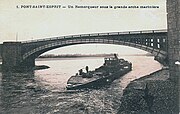Pont Saint-Esprit (bridge)
Coordinates: 44 ° 15 ′ 33 ″ N , 4 ° 39 ′ 7 ″ E
| Pont Saint-Esprit | ||
|---|---|---|
| use | Road bridge | |
| Crossing of | Rhône | |
| place | Pont-Saint-Esprit | |
| construction | Stone arch bridge | |
| overall length | 853 m | |
| Number of openings | 19th | |
| start of building | 1265 | |
| completion | 1309 | |
| location | ||
|
|
||
The Pont Saint-Esprit (also Pont du Saint-Esprit ; German roughly: Heilig-Geist-Brücke ) is a road bridge over the Rhône , which connects the town of the same name in the Gard department in the Occitania region on the right bank of the river with the district Le -Bout-du-Pont ( end-of-the-bridge ) connects the commune of Lamotte-du-Rhône in the Vaucluse department in the Provence-Alpes-Côte d'Azur region . Most of the bridge now belongs to the municipality of Lamotte-du-Rhône.
description
The bridge, built between 1265 and 1309, had 20 stone arches , including 13 larger and 7 smaller ones. In the 19th century, the first two arches in front of the town's sea wall were replaced by a large cast iron arch. A concrete arch from the 1950s now stands in its place. The bridge does not run in a straight line, but shows a clear kink after the first 12 arches, followed by smaller deviations from a straight line.
It has one lane for each direction and a very narrow walkway on the south side. The terraces on the pillar of the great arch and a niche about two thirds of the length offer pedestrians a place to rest.
The length of the bridge is often given as 919 m. In fact, it is about 856 m long, 72 m of which is accounted for by the modern concrete arch and its strong pillar. The stone arches are segmented arches of different widths and heights with spans of up to 30 m. The smaller arches over the flood bed on the left bank barely protrude from the alluvial soil. The pillars stand on wide foundations over which boulders have been piled up to prevent scouring . All pillars have through openings to reduce the water pressure on the bridge in the event of a flood.
history
The stone arch bridge, built from 1265 to 1309, is the oldest existing bridge over the Rhône. For a long time it was the only stone bridge between Lyon and the sea and the longest bridge in Europe.
There are various legends about its construction , including that the Holy Spirit convinced an abbot who opposed the construction of its necessity and that the bridge was built by the Frères Pontifes , a religious bridge brotherhood . However, her name probably goes back to a Holy Spirit chapel that used to stand next to her. It seems certain that the bridge goes back to wealthy traders in the place originally called Saint-Saturnin-du-Port (Latin: Portum Sancti Saturnini ), who founded a brotherhood to raise the necessary funds, mostly from religiously motivated donations, which are nowadays known as non-profit Club would denote. During their work on the construction site, the craftsmen were subject to common rules that also had religious content, but were not tied to a religious order. The construction by a bridge brotherhood is a myth that emerged only three centuries later and was developed in the period of Romanticism , but has survived to this day.
The bridge suffered from the recurring floods of the Rhône and from different subsidence, which meant that it had to be repaired again and again and was temporarily only released for pedestrians and empty wagons, while the cargo had to be brought across the river by ferry . In 1686 it was reinforced and widened.
In the course of the 19th century, steamships became so powerful that tug trains were able to overcome the strong currents of the Rhône. To enable them to pass through, the first pillar was blown up in 1856 and a cast iron arch with a span of 60 m was installed in place of the first two stone arches . The cast-iron parts were made in the Émile Martin foundry in Fourchambault on the Loire (as was the case with the Nevers railway bridge and the Tarascon – Beaucaire railway bridge ) .
In World War II, this cast-iron arch was destroyed and then in the shape of today's reinforced concrete arch rebuilt.
Since the creation of the Canal de Donzère-Mondragon with the André Blondel hydroelectric power station , only little water has flowed through the old river bed, so that a large part of the bridge stands on the mostly dry flood bed.
Web links
Rhone bridge Pont-Saint-Esprit. In: Structurae
Individual evidence
- ↑ Measurements in Google Earth and on the aerial photo of Géoportail
- ↑ In Lyon, the Pont de la Guillotière is first mentioned in a document in 1183 and completed in 1190, but soon destroyed again and rebuilt several times. A wooden bridge stood in Avignon between 1185 and 1226. The stone Pont Saint-Bénézet ( Pont d'Avignon ) was built between 1226 and approx. 1293, but not long afterwards partially destroyed and finally abandoned in 1660.
- ↑ a b c Jean Mesqui: Le Pont en France avant le temps des ingénieurs. Picard, Paris 1986, ISBN 2-7084-0322-2 , p. 34
- ^ A b Alain Girard: Ouverture du Pont Saint-Esprit on Archives de France



